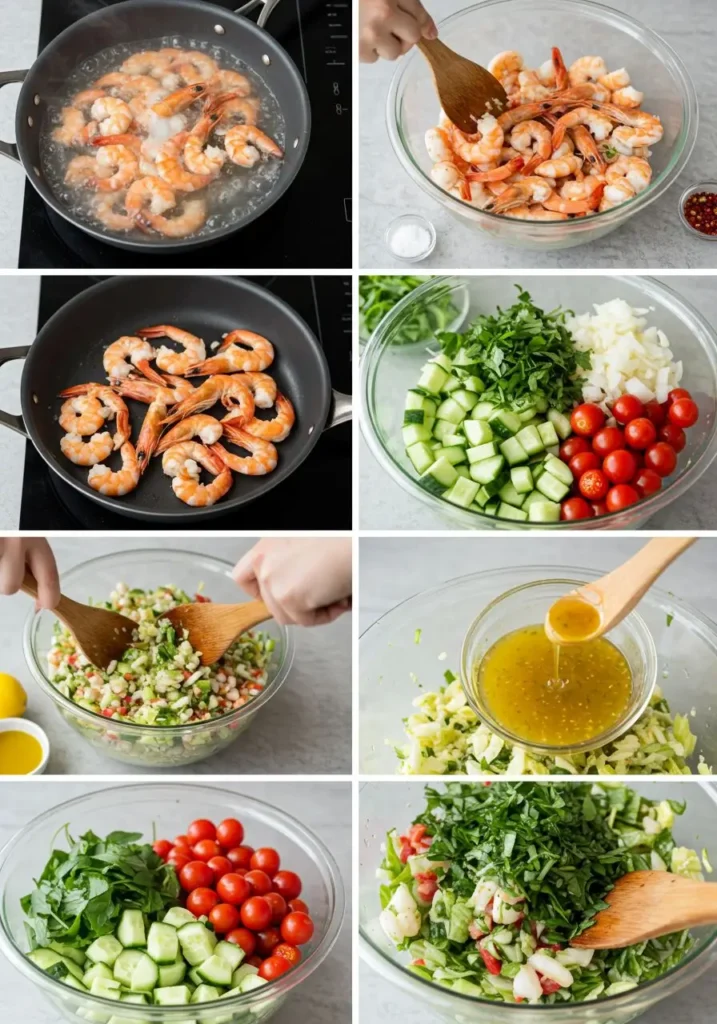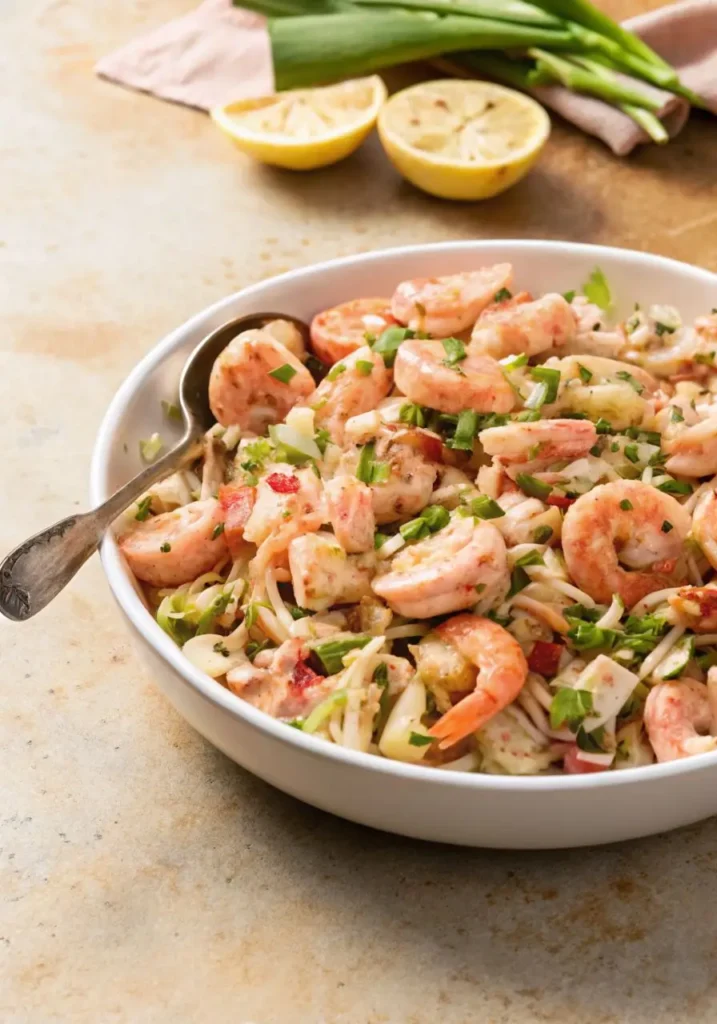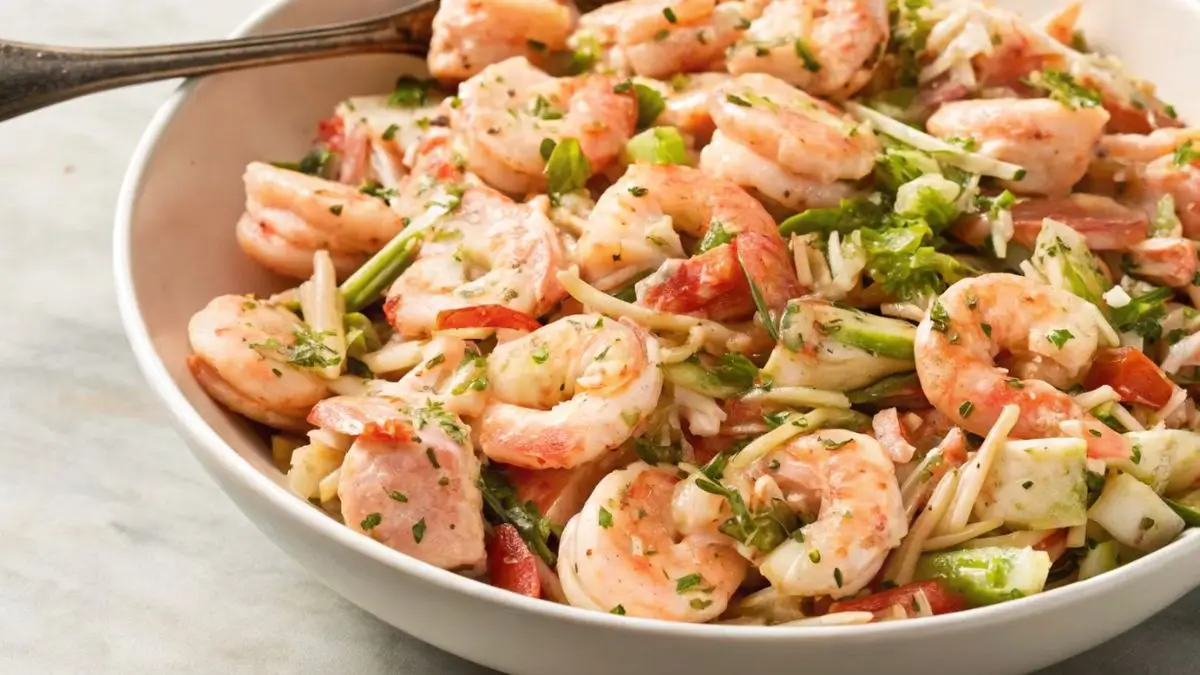Tired of dry, bland lunches that leave you hungry an hour later? You’re not alone. Many of us struggle to find meals that are both satisfying and good for us. The usual go-to options—salads loaded with heavy dressings or protein-packed dishes that take forever to prep—don’t always fit into our busy lives or health goals.
Enter the seafood salad—a bowl packed with fresh flavors, lean proteins, and brain-boosting nutrients. This isn’t your grandma’s mayo-heavy mix; we’re talking vibrant, zesty, and customizable dishes that leave you feeling energized, not sluggish.
As a seasoned content strategist and food lover obsessed with crafting easy, delicious meals, I can tell you: a great seafood salad strikes the perfect balance of convenience, nutrition, and taste. Whether you’re a gym-goer, a meal prep pro, or someone just looking to clean up your eating habits, this recipe is your new favorite.
Table of Contents
Why This Seafood Recipe Works
Let’s cut to the chase: seafood salad is a game-changer. There are plenty of good reasons to add this to your weekly meal plan.
- Uses affordable, easy-to-find seafood: Think shrimp, crab, scallops, or even canned tuna—available at most local grocery stores.
- Marinate in 15 minutes for max tenderness: No need for hours of prep—this dish comes together quickly and absorbs flavor fast.
- Perfect for weeknights or weekend feasts: Light enough for lunch, satisfying enough for dinner, and fancy enough for a brunch spread.
You get a nutrient-dense meal loaded with Omega-3s, lean protein, and vibrant veggies. Plus, it’s customizable based on your preferences—spicy, tangy, creamy, or herby? You decide.
And did I mention cleanup is a breeze? This dish is the perfect go-to for anyone with a busy lifestyle who still wants to enjoy something wholesome and satisfying.
Choosing the Right Seafood
Choosing the right type of seafood is key to creating a salad that’s both delicious and well-balanced. Not all seafood works the same way in a salad, so knowing what to look for can help you create a dish that’s light, fresh, and packed with taste.
Best Options for This Recipe
When it comes to building a great seafood salad, choose seafood that’s tender, easy to prepare, and holds its shape well. Here are some top picks:
- Shrimp: They cook fast, absorb marinades beautifully, and bring a slightly sweet flavor that pairs with many dressings.
- Crab meat: Whether real or imitation, crab adds a delicate taste and soft texture that works great in creamy or tangy salads.
- Scallops: Sweet, tender, and a bit more upscale—they’re ideal if you want to impress.
- Tuna: Canned tuna is affordable and versatile, while grilled or seared fresh tuna brings bold flavor and a meaty texture.
- Salmon: Rich in omega-3s and very satisfying, flaked salmon adds a buttery flavor that balances well with zesty dressings.
Smart Buying Tips
- Choose fresh seafood that smells clean and ocean-like—not fishy.
- Frozen seafood is a great backup—look for wild-caught options with minimal additives.
- If you’re buying shrimp, go for options that are already cleaned and deveined—it’ll save you prep time in the kitchen.
- For the freshest choices, ask your fishmonger what’s currently in season.
Simple Substitutions
Don’t worry if your go-to seafood isn’t available. You’ve got flexible options:
- Out of shrimp? Try grilled chicken or even tofu for a non-seafood version.
- Not a fan of crab? Swap in white fish like tilapia or cod, flaked into bite-sized pieces.
- Want a plant-based twist? Use chickpeas or artichoke hearts to mimic the texture of seafood without the fish.
The key is to choose ingredients that blend well with the other flavors in your salad—fresh veggies, herbs, and dressings—so every bite feels balanced and satisfying.
Ingredients & Prep
Let’s get everything prepped and ready. A great seafood salad starts with clean, fresh ingredients and a few pantry staples.

Seafood Prep Essentials
- Clean your seafood thoroughly—rinse under cold water and pat dry.
- For shrimp, remove shells and tails, and devein if not already done.
- If using canned seafood, drain well and flake with a fork.
- For raw seafood, bring to room temperature before cooking for even results.
Marinades/Rubs
Marinades make the magic happen. Here’s a simple citrus-based one:
Citrus Marinade Recipe:
- 3 tbsp olive oil
- Juice of 1 lemon
- 2 tsp minced garlic
- 1 tsp Dijon mustard
- Salt & pepper to taste
- Optional: chopped parsley or dill
Soak your seafood in marinade for just 15 to 30 minutes—any longer and the texture might break down.
Pantry Staples
Keep these on hand for bold, balanced flavor:
- Cold-pressed olive oil is a great source of healthy fats and serves as a rich.
- lemon juice (adds brightness)
- Dijon mustard (emulsifies dressings)
- Paprika, cayenne, cumin (spice options)
- Fresh herbs like parsley, cilantro, dill, or basil
Step-by-Step Cooking Instructions
Cooking seafood might sound intimidating, but it’s actually quite simple—and fast. The key is treating it gently and keeping an eye on timing. Follow these easy steps to cook your seafood perfectly every time for a fresh, flavorful seafood salad.

Pre-Cooking Prep
Before you start cooking, take a few minutes to prep your seafood properly.
- First, pat the seafood dry using paper towels—this helps it sear better and avoids excess moisture in the pan.
- Season lightly with salt, pepper, and any herbs or spices you like.
- Let it rest at room temperature for 10–15 minutes—this ensures even cooking and prevents the seafood from being cold in the center.
Cooking Method
You have a few great cooking methods to choose from, depending on your tools and preference.
- Sautéing: Heat a little olive oil in a non-stick or stainless-steel pan over medium heat. Add shrimp, scallops, or small fish pieces, and cook for 2–3 minutes per side, or until opaque and lightly golden.
- Grilling: For a smoky flavor, grill seafood on medium heat. To keep delicate seafood intact on the grill, thread shrimp onto skewers or place flaky fish in a grill basket.
- Boiling/Poaching: Ideal for shrimp or crab—boil water with a pinch of salt and a squeeze of lemon. Cook seafood until just opaque (usually 2–4 minutes), then drain and cool.
Choose whichever method suits your style, but be mindful not to overcook—seafood cooks fast and becomes rubbery if left too long.
Checking for Doneness
You’ll know your seafood is cooked when it looks solid in color and breaks apart easily with a fork. Here are some quick tips:
- Shrimp: Turns pink and curls into a “C” shape.
- Scallops: Should be firm and golden on the outside, soft and white inside.
- Fish fillets: Flake apart easily and have no translucent spots.
- Internal temperature should be around 145°F (63°C) for most seafood.
Resting the Seafood
After cooking, allow the seafood to sit for 3 to 5 minutes—this helps lock in moisture and keep each bite tender. This brief pause helps the juices settle inside, keeping the texture moist and tender. After resting, cut or flake the seafood as needed and mix it into your salad for a delicious, protein-packed meal that’s ready to serve.
Pro Tips for Perfect Seafood
Want to take your seafood salad from good to unforgettable? A few smart kitchen tips can completely elevate both the taste and texture of your dish. Here’s what seasoned cooks know that beginners often overlook.
Avoiding Tough/Dry Seafood
Overcooked seafood is the most common mistake. Here’s how to dodge that kitchen disaster:
- Give seafood enough space in the pan so it cooks evenly and doesn’t steam instead of sear.
- Use medium-high heat: Too low and seafood stews in its own juices, too high and it turns rubbery.
- Quick searing: A 2–3 minute sear per side is usually enough for shrimp or scallops.
- Baste with butter: Just before removing from heat, spoon some melted butter over your seafood to lock in moisture and add richness.
Tool Recommendations
Using quality kitchen equipment helps you work more efficiently and achieve better results in your dishes:
- Digital Seafood Thermometer: Ensures perfect doneness every time.
- Cast-Iron Skillet: Great for getting a golden sear without sticking.
- Citrus Zester: Brighten up flavors with fresh lemon or lime zest.
If you’re prepping seafood regularly, these tools are worth every penny.
Storage & Reheating
Seafood salad can be meal-prepped for busy days, but handle leftovers with care:
- Place leftover seafood in a sealed container and refrigerate it—it’ll stay fresh for about three days.
- For longer storage, freeze in olive oil or a bit of broth for up to 2 months—this helps preserve moisture.
- Reheat gently over low heat or let it come to room temperature for cold salads. Skip the microwave when reheating seafood, as it can quickly make it rubbery or dry.
Flavor Variations
The beauty of seafood salad is how versatile it is. Whether you’re cutting carbs, watching sugar, or craving a new flavor, you’ve got options.

Spicy Twist
If you like heat, fire it up:
- Add chipotle peppers in adobo, red chili flakes, or a drizzle of sriracha.
- A spicy mayo (just mayo + hot sauce) makes a great creamy dressing.
- Toss in some jalapeño slices or pepperoncini for a zesty crunch.
Keto/Paleo-Friendly
Going low-carb or following a clean eating plan?
- Use avocado oil or olive oil-based dressings—they’re keto-approved.
- Ditch sugar and use apple cider vinegar for tang without carbs.
- Add healthy fats like avocado slices, olives, or nuts for satiety.
Global Flavors
Take your tastebuds on a world tour with these ideas:
- For a Mediterranean-inspired: version, mix in ingredients like kalamata olives, crumbled feta, sun-dried tomatoes, and a sprinkle of oregano.
- Asian: Use a sesame-soy-lime dressing with shredded carrots and edamame.
- Italian: Toss in cherry tomatoes, basil, and balsamic glaze.
- Mexican: Try corn, black beans, cilantro, and a squeeze of lime over grilled shrimp.
Each version brings a new personality to the same basic dish—so you never get bored.
Serving Suggestions
You’ve nailed the prep, cooked everything just right, and now you’re ready to serve. Wondering what sides or pairings complement a seafood salad best?
Pair with Sides
Depending on your vibe—light lunch or hearty dinner—you’ve got plenty of great side options:
- Light: A crisp cucumber salad, steamed asparagus, or quinoa.
- Hearty: Roasted sweet potatoes, couscous, or garlic bread.
- Brunch: Serve on croissants, in wraps, or over avocado toast.
Conclusion
So, are you ready to upgrade your weekly menu with a dish that checks every box—healthy, delicious, and fast to make? This seafood salad is more than just a meal—it’s a nutritional powerhouse disguised as a flavorful, refreshing treat.
You’ve got all the tools: smart seafood choices, easy prep, pro-level tips, and creative ways to mix it up. Whether you’re meal prepping for the week, hosting brunch, or just want a lighter dinner that actually satisfies, this recipe fits the bill.
Fire up your grill, sharpen that knife, and treat yourself to a bowl of seafood salad tonight! And hey, don’t just take our word for it—join thousands of home cooks who are loving this recipe and making it their own with every twist and variation.
FAQs
1. Is it okay to prepare seafood salad in advance?
Yes! You can whip it up a few hours or even the night before and keep it chilled until you’re ready to serve. Just keep it chilled in the fridge and add any fresh greens right before serving.
2. What seafood works best in a salad?
Shrimp, crab, scallops, tuna, and salmon are all great choices. They cook quickly and blend well with dressings and veggies.
3. Can I use frozen seafood?
Yes, frozen seafood works fine. Thaw it safely in the fridge and pat it dry before cooking to avoid soggy texture.
4. Is seafood salad healthy?
Absolutely! This salad is loaded with nutritious ingredients—lean proteins, good fats, and crisp, fresh vegetables that fuel your body. Just go easy on creamy dressings if you’re watching calories.
5. How long can seafood salad be kept refrigerated?
Seafood salad stays fresh for up to 3 days when stored in an airtight container in the refrigerator. For the best flavor and texture, enjoy your seafood salad chilled or let it sit out briefly to reach room temperature before eating.
Do you have questions about Seafood Salad? Drop them in the comments and let’s get cooking!

